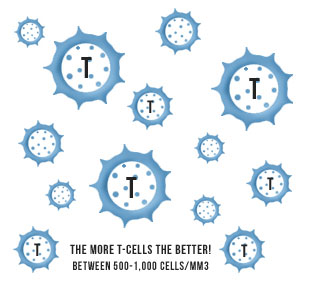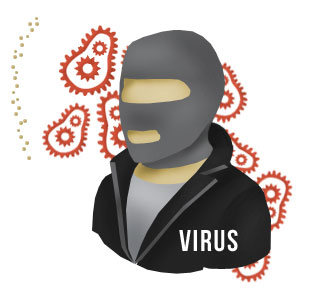What is a CD4 cell or T-cell?
CD4 cells or T-cells are the “generals” of the human immune system. These are the cells that send signals to activate your body’s immune response when they detect “intruders,” like viruses or bacteria.
Because of the important role these cells play in how your body fights off infections, it’s important to keep their numbers up in the normal ranges. This helps to prevent HIV-related complications and opportunistic infections. For more information, see the National Cancer Institute’s The Human Immune System.
The name game
You may have noticed that your healthcare providers often use the terms “T-cell” and “CD4 cell” interchangeably. When talking in terms of HIV, these two names mean the same thing. They both refer to the same type of cell. While there are many different types of T-cells, these particular cells have a specific receptor site on their surface called the CD4 receptor site. HIV uses this particular receptor to latch on to the T-cell, making it a prime target for infection.
It’s all about the numbers!
Ok, it’s not all about the numbers—but your CD4 count is one of the most important things to consider when you and your healthcare provider are deciding the best way—and time—to treat your HIV disease.
A normal CD4 count can range from 500 cells/mm3 to 1,000 cells/mm3. So if your CD4 count is within that range, the CDC does not generally recommend that you start treatment for your HIV disease, unless there are other concerns (pregnancy, young age, constitutional symptoms, acute retroviral syndrome, etc.).
The guidelines from the U.S. Department of Health and Human Services suggest starting treatment when your CD4 count falls to 350 cells/mm3 or below. T This is because opportunistic infections typically begin to affect people whose CD4 counts are below that level. (This is why a CD4 count is often used to determine the stages of HIV disease.)
Recent research has indicated that it may be easier to maintain higher CD4 counts if you start HIV treatment before your CD4 counts drop below 350 cells/mm3. You should discuss when to begin treatment with your healthcare provider and choose the approach that is best for you.
The Basics
- A normal CD4 count ranges from 500–1,000 cells/mm3.
- When your CD4 count is 350 cells/mm3 or less, it’s time to consider treatment.
- A CD4 count of fewer than 200 cells/mm3 is one of the qualifications for a diagnosis of AIDS.
- Your CD4 count can vary from day to day. It can also vary depending on the time of day your blood is drawn and on whether you have other infections or illnesses, like the flu or STDs.
- Typically, your healthcare provider will check your CD4 counts every 3-6 months.
Frequently Asked Questions
Are a CD4 count and a CD4 percentage the same thing?
No, these two measurements are not the same thing. A CD4 count tells you the number of CD4 cells or T-cells in a sample of your blood. The CD4 percentage tells you how many CD4 cells you have, relative to other immune-system cells in that sample. Both measurements tell you something important about the health of your immune system.
But a CD4 count can vary as much as 50-100 cells/mm3 from one day to the next. Because of this, many providers and experts feel that your CD4 percentage is a more accurate measurement of your immune function.
- A CD4 percentage that is greater than 29% usually means that your immune system is functioning normally (i.e., your CD4 count is roughly >500 cells/mm3).
- A CD4 percentage of 14%-28% typically means your CD4 count is in the range of 200-500 cells/mm3.
- When your CD4 count is below 200 cells/mm3, your CD4 percentage is likely to be below 14%.
This information taken from the 2007 Medical Management of HIV Infection, Bartlett and Gallant, 2007. Johns Hopkins University School of Medicine: http://www.hopkins-hivguide.org/management/laboratory_testing/cd4_cell_count.html?contentInstanceId=8279&siteId=7151
Additional Resources
- National Cancer Institute - The Human Immune System
- Department of Veterans Affairs - CD4 count and viral load
Last revised: 10/11/2010



